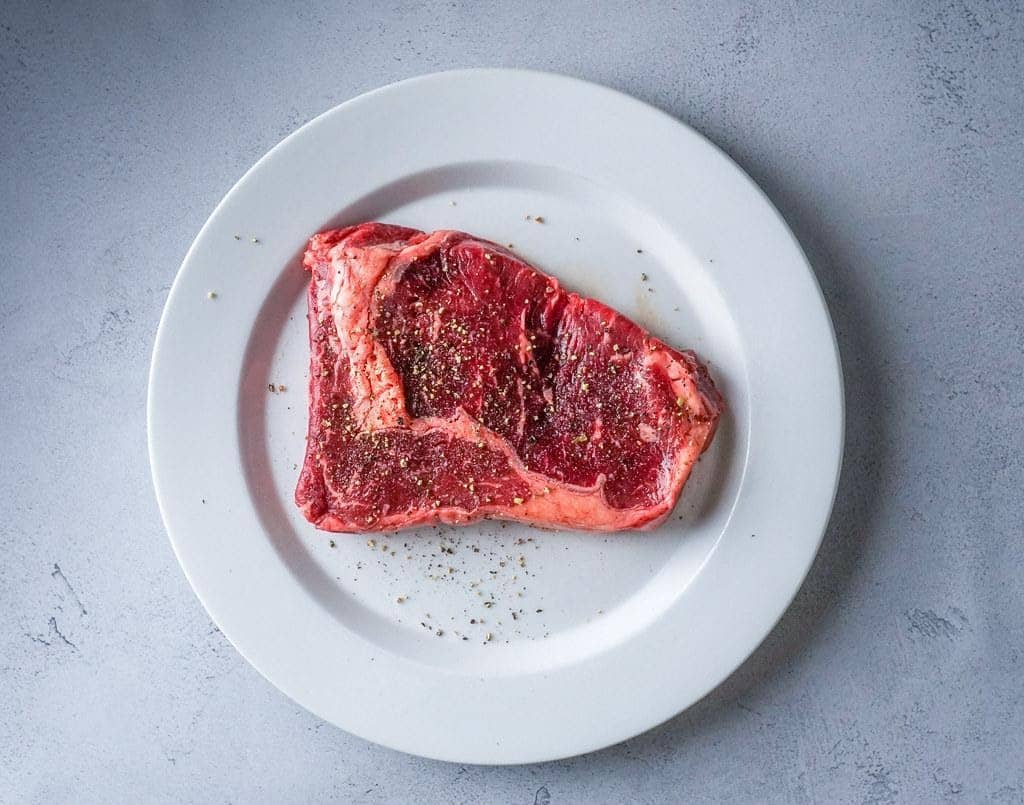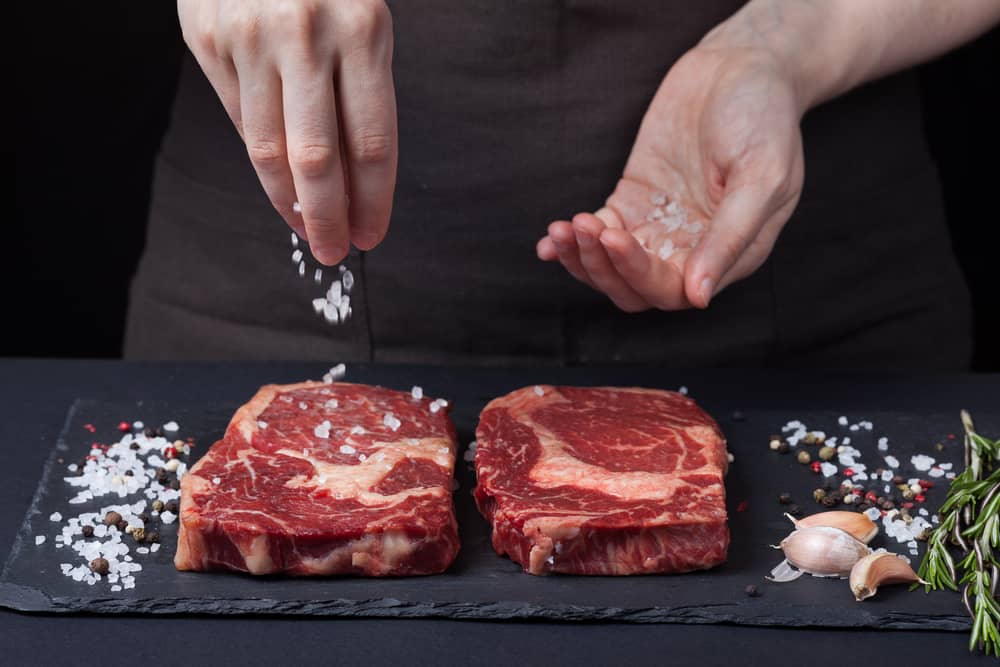
You’ve bought an incredible ribeye steak, and you’re ready to toss it onto the grill or your favorite cast iron skillet. But, wait! You’re not going to start cooking a ribeye without some steak seasoning, are you?
Of course not. Even unseasoned cooks (see what we did there?) know that a good rib eye steak — and any steak, for that matter — needs a good sprinkle of salt, at least. But if you’re not sure exactly what you should be putting on your ribeye steak and how to do it, you might not get the full steakhouse experience you were looking for.
This guide is going to help you with that. We’ll explain why it’s important to season ribeye steak, what to use to season ribeye, and how to season ribeye steak to perfection, whether you’re using the grill or a skillet.
The Reason to Season
Just about every steak recipe touts the need for seasoning, even if it’s just a sprinkle of Kosher salt and black pepper. You probably realize that much of the need for seasoning is simply to bring out more flavor in the steak. Once you add Kosher salt and pepper to the steak, you’ll have a more intense flavor in every bite. But there’s a little more to the story than that.
Another reason seasoning is an incredibly important part of steak is that, when used generously, seasoning lends to the sear on the steak. Sprinkle your ribeye steak with fresh thyme and sea salt, and you’ll end up getting those seasonings crispy, too, forming a delightful outer crust.
Even more importantly, salt actually works some magic on ribeye and other steaks. When you salt your ribeye and allow it to rest before you grill or cook it, the salt absorbs the meat’s natural juices, creates a brine, and soaks back into the steak. You’ll still get a nice, juicy ribeye that also has a natural brine to help form a sear. Seasoning = science!
How to Season Ribeye Steak
Ribeye steak needs seasoning, just like your other favorite cuts of steak. And, it needs seasoning whether you’re making a grilled rib eye steak, a baked ribeye steak recipe, or a pan-seared ribeye. Here’s how to get all that flavor into your meat.
What to Use

What type of seasoning should you use with rib eye? No matter what else you want to use, always grab some salt. As we mentioned, salt is the seasoning that’ll create a brine that flavors and tenderizes steak, so it’s a must when you’re cooking ribeye.
As far as other seasoning to use, that’s more up to your personal preferences. Many people prefer to add some black pepper whenever salt is involved, so it’s common to use freshly ground black pepper with ribeye steak. You can also use garlic, thyme, tarragon, minced onion, and whatever other seasonings you enjoy with steak.
When to Do It
There’s somewhat of a debate about when the best time is to season ribeye steak. Honestly, there’s a couple of ways you can go with it.
Your first option is seasoning immediately before you make grilled ribeye steak or put your ribeye on a cast iron skillet. Doing so won’t allow the salt in your seasoning to create its brine, so the salt won’t pull out any of the steak’s juices. You’ll still get the salt flavor, but you can move onto the cooking process quicker when you’re short on time.
Another optimal time to season is about 40-45 minutes before you cook or grill ribeye steak. This is our personal favorite, leading to the perfect ribeye steak that’s tender, juicy, and filled with beefy flavor. Ribeye is a thicker steak that takes some time for the salt to pull its juices through when creating a brine. The total process to pull juices and flow them back into a ribeye will take 40-45 minutes, which is why it’s a good idea to season, wait that time, and then start cooking.
If you do decide to season 40+ minutes before cooking, keep the meat at room temperature tented with foil while it basks in the seasonings.
How to Do It
There’s one important word you’ll need to know when it comes to seasoning seared or grilled ribeye steak: generously. You should get into the habit of seasoning generously with steak, rather than sprinkling salt and pepper here and there. Steaks love a good seasoning, and your taste buds will appreciate it even more.
When you season ribeye, add plenty of seasoning — enough that you can plainly see it on the surface. Because it’s a thicker steak, you’ll want extra seasoning, as it sits on the outside of the steak rather than inside. When you bite into the steak, the extra seasoning on the outside will also help flavor the rest of the bite that doesn’t have seasoning on it.
Keep your seasonings in a bowl and pinch a portion with your fingers. Then, sprinkle it generously all over the steak on all sides. Make sure you get around the edges, too. Press the seasoning gently into the meat to help it adhere.
More Seasoning?
Another common question is whether you should season ribeye after you cook a ribeye steak. Some people who like a lot of salt and pepper might add more to their ribeye after they’ve cooked or grilled steak.
The jury says: There’s absolutely nothing wrong with that (as long as you’ve already done your due diligence with seasoning beforehand!). You’re not going to harm anything by doing so. In fact, it’s a good way to make sure you don’t overseason your ribeye for someone else’s tastebuds. If you prefer more seasoning, you can always sprinkle extra on your portion before you eat it. There’s also garlic butter, herb butter, or steak sauce, all of which are options for adding even more flavor to your ribeye after cooking.
Does Cooking Method Make a Difference?
Whether you’re grilling steak or cooking it on a cast iron pan, you can season it the right way. Some might argue that adding black pepper to your steak before cooking it, especially when searing it on a cast iron skillet, can burn the black pepper and create a bitter taste. However, plenty of others consistently use freshly ground black pepper as part of their before-cooking seasoning, and swear by it.
Again, this is a personal preference. But as long as you’re not burning the steak instead of searing it, you shouldn’t have a problem. As for salting your steak, you can use the above seasoning method with whatever method of cooking you prefer.
How to Season Ribeye Steak for the Perfect Steak Meal
We’ve dished about how to season ribeye steak for the perfect ribeye steak in your very own kitchen. Now, it’s time to test it out! Grab yourself some USDA Prime ribeye steaks from Chicago Steak Company. We’ll get them sent to your home within 5-7 business days, ready for you to enjoy with your family. Don’t forget to browse the rest of Steak University to find recipes, cooking tips, and more inspiration for your yummy steak dinner.

